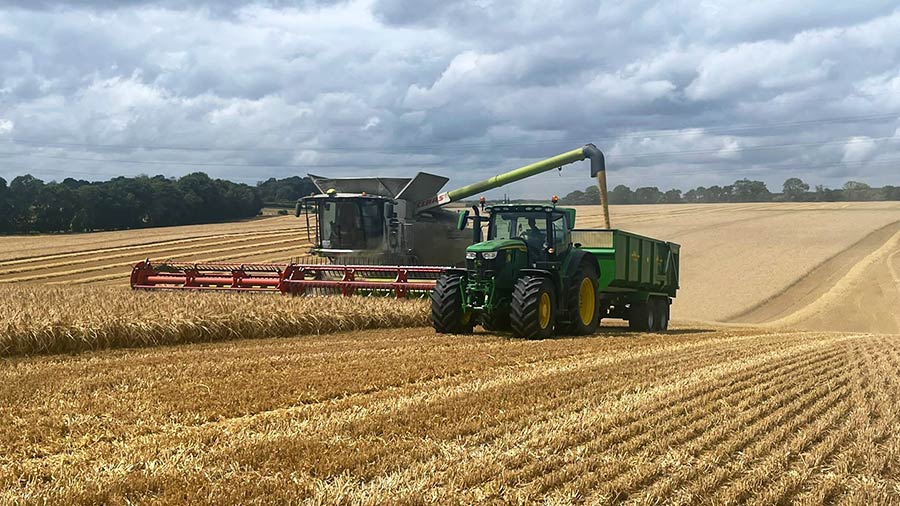Stop-start winter barley harvest yields well despite storms
 Winter barley harvest 2023 on Trinley Estate © Corey Vasey
Winter barley harvest 2023 on Trinley Estate © Corey Vasey Winter barley harvest has been a stop-start affair at the Trinley Estate in Hampshire, where farm manager Mike Farrell began cutting the hybrid variety Thunderbolt last week, with yields of just over 10t/ha.
Despite the above-average yields, the crop battled a freak thunderstorm last week, with strong winds and 31mm of rain which caused it to lodge.
“Moisture levels are coming in higher than we would like at 17%, so we are having to dry the grain. However, the Claas Lexion with 35ft Convio Flex header is doing an amazing job at picking the crop off the floor,” says Mike.
See also: Harvest 2023 photo competition: Chance to feature on FW’s cover
“I’d rather have the crop in the shed and dry it than risk any crop loss due to more heavy rain.
“Interestingly, the next-door field has two-row variety Tardis, which is stood much better, so I look forward to seeing how that delivers in comparison with the six-row hybrid.”
Harvest commenced on Thursday 6 July at the 650ha estate near Andover. The Trinley team, who crop just under 1,000ha in total with contract farming arrangements, are nearly halfway through the 140ha winter barley crop.
“The weather is not looking too promising, given the unsettled forecast. I’m currently combining and dark clouds are lurking in the distance.
“I think we all remember how easy last year’s harvest was with the dry weather- we didn’t have to dry a single grain. However, no two years are the same, so I’m not being complacent,” says Mike.
Positive outlook
Overall, things are looking positive and the barley is yielding above the farm’s five-year average of 8.5-9t/ha, with good straw yields.
A percentage of the crop has been sold forward, but as barley prices are £100/t down on last season’s price of £240/t and there is plenty of storage space on farm, Mike is happy to sit tight and wait for a better price later in the marketing year.
Wheat, spring barley and peas are showing good potential, but spring beans seem to have burned off in the summer heat and not podded as well as expected.
A switch to liquid fertiliser over the past two years has improved nutrition accuracy, with wider application weather windows compared with granular products.
“I’m convinced being able to get nitrogen on early set this crop up really well – probably too strong, but I’d rather that and manage it with plant growth regulators than the other way round.”
About half of the oilseed rape has been sprayed off, so it will be the next crop ready for the combine in about 10 days’ time, followed closely by Extase winter wheat.

